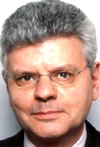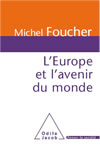Introducing Michel Foucher
 Michel Foucher (Montrouge, 1946) obtained his PhD at Sorbonne University in 1986.
Michel Foucher (Montrouge, 1946) obtained his PhD at Sorbonne University in 1986.
He is currently Professor of geography and geopolitics at the Ecole Normale Supérieure (Paris Ulm). Moreover, Mr Foucher is member of the Council of Foreign Affairs (Paris).
Previous positions of Mr Foucher include Ambassador to Latvia and head of the Policy Planning Staff of the Foreign Ministry. In addition, he has written extensively about borders, boundaries and frontiers. His most influential work is undoubtedly “Fronts et frontières” (1988, 1991).
He also edited two thought-provoking atlases, “Fragments d’Europe” (1998) and “Asies nouvelles” (2002). The interview addresses issues that Mr Foucher raised in aforementioned works and his second-last one, called “L’obsession des frontières” (2007). Topics comprise the various roles of borders and the influence of borders on security and identity. This interview provides non-French speakers a unique insight into Mr Foucher’s ideas which he has thoroughly discussed in numerous French publications. His new book “L’ Europe et l’avenir du monde” has just been published by Les Éditions Odile Jacob.
Interview
The role of borders
How do you define globalisation in “L’obsession des frontières”? What has been its impact on the role of borders?
 Globalisation (in French language “mondialisation”, from the word “world”, is more common) in its current phase refers to the potential capacity of firms to act in due and real time at a world scale through the implementation of information technologies on service industries. It indicates a double trend of access to new markets by western companies and the growing role of firms from emerging economies into mature markets.
Globalisation (in French language “mondialisation”, from the word “world”, is more common) in its current phase refers to the potential capacity of firms to act in due and real time at a world scale through the implementation of information technologies on service industries. It indicates a double trend of access to new markets by western companies and the growing role of firms from emerging economies into mature markets.
And for a geographer, it is an invitation to take into account what at a world scale may impact socio-economic situations at other scales. This flat economic world is supposed to be borderless since the waiting time at the border is perceived as an extra additional cost which should be removed and lowered (as it can be observed between the US and Canada when control on trucks is tighter). For those who think that the world is a market, borders are unnecessary obstacles.
Why do borders play a crucial role in keeping the world sustainable? (“…le monde, pour être vivable, a besoin de frontières”)?
Indeed, for those who think that economy is not the end of the game and doesn’t encapsulate societies and cultures, territories and international relations, borders are indispensable markers of identity, self-consciousness and diversity. Not borders conceived as barriers but as limits between “us” and “them”, between “inside” and “outside” since it is the interplay between both, the capacity to what is inside to open-up to the outside which makes collective life possible to live. The lack of symbolic markers may lead to closure and xenophobic populism.
In “Fronts et frontières”, you state that “La frontière n’est pas une idée neuve – voir la Chine, mais aussi la Grèce ou l’Egypte…”. To what extent is the current role of borders different from that in ancient history?
Borders have always been a component of territorial sovereignty, for empires, kingdoms and even chiefdoms. In-depth researches in African history show the reality of pre-colonial bordering between political entities. For centuries, central authority had the goal to make congruent the spaces of market, official language, customs, law and justice. And this necessity for delimitation and demarcation is obvious when new states or nation-states are created and recognized, as it was the case in Europe and Eurasia in the last two decades (and so between Ethiopia and Eritrea). To day the function of barriers tend to be lower to make trade and circulation less expensive and easier.
Borders of continents
Your book about Asia, “Asies nouvelles”, did not include Afghanistan and Central Asia. How could one support the point of view that Asia’s western border equals the western borders of Pakistan and China?
In “Asies nouvelles”, Afghanistan is studied and mapped as borderlands of Pakistan, which has been the case since the formation of the border, the Durand Line in 1893, and is nowadays referred to as “Afpak” in US strategy.
As for Central Asia, the choice was made to limit “Asia” to the more classical definition of “Asia of monsoons”. The different concepts of Asia are extensively discussed in the introduction. Central Asia is mentioned and mapped as an intermediary space between East Asia and Europe but I thought that Central Asia was still a part of former post-Soviet Russian sphere of influence.
A short chapter is dedicated to Russia as a possible continental bridge between East Asia and Europe and in the perspective of growing interaction with China, Japan and Southern Korea in the Far East. Geography is about the description of the world; several options are open to choices according to times.
In “Fragments d’Europe”, you write that “La question des limites de l’Europe n’est pas géographique mais géopolitique”. Could you elaborate on this?
Europe as a continent has moving limits according to internal and external historical dynamisms. I believe that there is a core Europe where societies and political entities have been part of the major structures of European history. I draw a series of maps to show the superposition of cultural and social layers. For centuries, Russia was on the margin, like the Ottoman Empire. Even if now both countries want to be part again of continental affairs, after the end of the Cold war.
The main issue is not about «Europe» as a continent whose limits changed during a long history but on the possible scenarios of extension of the European Union as the main configuration of to day organized Europe. Several options are possible, in terms of inclusion or association of several states of Eastern and South-Eastern Europe into the mainstream of the EU.
As for Central Asia, capitals are looking West with Gazprom and the plan of customs union with Kazakstan and East with Chinese oil companies. Russia has the key of easing the territorial enclosing of the new independent countries.
Borders and security
Twenty years ago, the Berlin Wall was demolished. Nowadays, heavily guarded walls along borders are gaining popularity. What is driving this trend?
It is true that around 3% of the land political borders are nowadays equipped to be hardened borders, with walls, electronic devices or barbed wire fences. Fencing is fashionable, notably in some democratic regimes where security issues are highlighted and dealt on the border scene (India, United States, Israel).
The American situation is a rather contradictory one since the southern border is both managed as a fence and very open to legal intercourse (more than 400 m crossings a year, both ways). Around India, the western sections are closed and militarized against the permanent foe, Pakistan; in the eastern sections, migration control mix up with anti-rebellion surveillance. In Israel, no doubt that the “security fence” is also the basis for a new political border, twice longer than the “green line”.
In Northern Ireland, the fear between close political communities is the factor behind of so-called “peace lines, higher than before the Good Friday agreement. Fear and policies of (in)security are the main drivers for fencing in the border scene which looks like a counter-model for the “borderless world”.
There is much criticism on the origin of most African borders. However, the African Union (formerly OAU) has always respected these borders. In how far could an adjustment of African borders have a positive effect on the security of the continent?
It is correct to say that the Cairo principle of “intangibility” (1964) has been respected, except in the Horn of Africa (Eritrea). The principle will be reaffirmed during the next meeting of ministers in charge of border issues, in Cairo again, next November 2009.
Actually, this wise principle will be under pressure if Southern Sudan opts for independence after the 2011 referendum (which will be refused by Khartoum) and it is already challenged by Somaliland, living apart from a non-State, Somalia. In Central Africa, some countries like the DRC rightly complain about the tendency of some neighbours to grab some pieces of territory, the richest ones.
Minor and local adjustments may be useful to conclude a disagreement; it was the case in Bakassi peninsula after the judgment by the International Court of Justice (2008) which asked Nigeria to give back a district to Cameroon.
In “Fronts et frontières”, you state that “Si des frontières posent problème aujourd’hui…c’est moins parce qu’elles découpent que parce qu’elles regroupent”. Do you think that borders have caused more tensions within countries than between countries?
When a post-colonial border is cutting a homogenous ethnic area, a problem arises when a government is blocking trade and circulation. If it is possible to travel and exchange, like in Haussa region between Niger and Nigeria or in the tri-national confines of the Bobo Dioulasso, Korhogo and Sikasso, the political borders are utilized as “resources”, as assets.
Many political problems facing African states are linked to internal competition where political parties may represent the interests of a specific ethno-linguistic region first. And when the access to political power is a key element to get access to economic resources, it is not lucky to lose elections. It means that democracy may impose a kind a “revolving table” around which everybody feels secure as being part of the game.
One example of political crises linked to tensions between North and South was in Ivory Coast where parties and leaders of the regions were not able to compromise. Somalia is a tragic example of that because clans are winning precedence over national interest in a theoretically very homogenous nation (one language, one ethnic set,…..).
Borders and identity
In “L’obsession des frontières”, you write “Pas d’identité sans frontières”. Why are borders essential for national identity?
The answer derives from what I said in the first two questions. My view draws from the philosopher Emmanuel Kant. To feel citizen of a national political community there is a need for “markers”, “symbols” both in time and space. In time frame, the national narrative with its components gives basis for such an “ownership”, provided history is still alive; in space, with a territory and its limits. I tend to think that the crisis of European political consciousness is partly linked to the lack of definition of its limits, and the loss of memory of what has been achieved, let’s say in the last 20 years.
What are “meta-frontières”? Do you expect new ones to emerge in the 21st century?
They used to be major ideological cleavages, like East and West and their respective competitive ideologies. The former lost. Nowadays, it can point out major differences at the world scale: juridical regimes (Roma, law, common law, Islamic law, customary rules), accountancy norms, major categories of political regimes (eg Freedom House index on democracies versus authoritarian regimes), religions seen as cultures.
